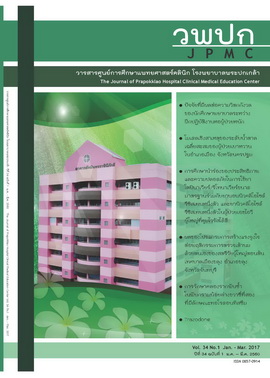โมเดลเชิงสาเหตุของระดับน้ำตาลเฉลี่ยสะสมของผู้ป่วยเบาหวาน ในอำเภอเมือง จังหวัดนครปฐม
Main Article Content
Abstract
ที่มาของปัญหา : โรคเบาหวานเป็นโรคที่ทำให้คุณภาพชีวิตของผู้ป่วยลดลง ดังนั้นจึงควรศึกษาปัจจัยที่สัมพันธ์กับระดับน้ำตาลเฉลี่ยสะสมของผู้ป่วยเบาหวาน เพื่อนำมาเป็นข้อมูลพื้นฐานในการจัดบริการสุขภาพอย่างเหมาะสม
วัตถุประสงค์: การวิจัยนี้มีวัตถุประสงค์เพื่อพัฒนาโมเดลเชิงสาเหตุของระดับน้ำตาลเฉลี่ยสะสมของผู้ป่วยเบาหวานในเขตอำเภอเมือง จังหวัดนครปฐม และตรวจสอบความสอดคล้องของโมเดลกับข้อมูลเชิงประจักษ์
วัสดุและวิธีการ: เป็นการวิจัยเชิงพรรณนา กลุ่มตัวอย่างเป็นผู้ป่วยเบาหวานชนิดที่ 2 ในเขตอำเภอเมือง จังหวัดนครปฐมจำนวน 224 คนเครื่องมือที่ใช้ในการวิจัยประกอบด้วย แบบสอบถาม ข้อมูลส่วนบุคคล พฤติกรรมการสร้างเสริมสุขภาพของผู้ป่วยเบาหวานและความเชื่อด้านสุขภาพ มีค่าความเชื่อมั่นเท่ากับ 0.83 - 0.87 วิเคราะห์ระดับน้ำตาลเฉลี่ยสะสมโดยใช้เครื่อง Dimension RxL Max Integrated Chemistry System เก็บรวบรวมข้อมูลระหว่างเดือนเมษายน พ.ศ. 2557 วิเคราะห์ข้อมูลโดยใช้โมเดลสมการโครงสร้าง (structural equation model)
ผลการศึกษา: ผลการศึกษาพบว่า โมเดลเชิงสาเหตุของระดับน้ำตาลเฉลี่ยสะสมของผู้ป่วยเบาหวาน ที่พัฒนาขึ้น มีความสอดคล้องกลมกลืนกับข้อมูลเชิงประจักษ์ (x2= 3.440, df = 13, p = 0.996, GFI = 0.987, AGFI = 0.960, RMSEA=0.0289, x2/df = 0.265) พฤติกรรมการสร้างเสริมสุขภาพมีอิทธิพลทางตรงในลักษณะแปรผกผันต่อระดับน้ำตาลเฉลี่ยสะสมของผู้ป่วยเบาหวาน นอกจากนั้นความเชื่อด้านสุขภาพยังมีอิทธิพลทางอ้อมต่อระดับน้ำตาลเฉลี่ยสะสมของผู้ป่วยเบาหวานโดยส่งผ่านตัวแปร พฤติกรรมการสร้างเสริมสุขภาพ
สรุป: ผลการวิจัยครั้งนี้แสดงให้เห็นว่าความเชื่อด้านสุขภาพและการมีพฤติกรรมการสร้างเสริมสุขภาพมีอิทธิพลต่อระดับน้ำตาลเฉลี่ยสะสมของผู้ป่วยเบาหวานหากมีการจัดบริการที่สร้างความรู้ความเข้าใจที่ถูกต้อง เกี่ยวกับความเชื่อด้านสุขภาพและเน้นการมีพฤติกรรมสุขภาพที่เหมาะสม
A Causal Model of HbA1C among Diabetes Mellitus Patients in Muang District, Nakhon Pathom Province
Abstract
Background : Diabetes mellitus is a disease that diminish as quality of life of patients. Therefore, the investigation of factors related to HbA1C of patients with diabetes should be done and the results can be used as background information in order to deliver health services appropriately.
Objective: This study aimed to develop and validate a causal model of HbA1C among diabetes mellitus patients in Muang District, Nakhon Pathom Province.
Material and Method: The study design was a descriptive research. The samples comprised of 224 patients with diabetes. Demographic data, health promoting behaviors, and health believe questionnaires were used to conduct the data. Internal consistency reliability ranged from 0.83 to 0.87. HbA1C level was calculated by using Dimension RxL Max Integrated Chemistry System. The data were collected in April, 2014. Structural equation model was used to analyze the data.
Results: The findings illustrated that the causal model of HbA1C among diabetes mellitus patients was consistent with the empirical data as demonstrated by the fit measures (χ2 = 3.440, df = 13, p = 0.996, GFI = 0.987, AGFI = 0.960, RMSEA= 0.0289, χ2/df= 0.265). HbA1C was inversely influenced by health promoting behaviors. Furthermore, health believes were indirectly affected HbA1C level by entering a health promoting as a mediator.
Conclusion: The results in dicated that health believes and health promoting behaviors could affect HbA1C level among patients with diabetes. Consequently, enhancing health believes and health promoting behaviors should be provided for the patients.

